The brick wall gradually collapses under the influence of moisture and temperature drops, especially the facade. You can protect it by covering with siding, plastering. Painting a brick wall will be a reliable and beautiful protection. The work does not require special training and sophisticated equipment. You can do it yourself in several stages:
- cleaning the wall;
- sealing cracks;
- primer;
- painting.
Work can only be carried out in warm time year and in sunny weather, especially outdoors. The brick must be dry and the masonry must shrink. The wall should not be painted earlier than one year after the completion of construction.
First, you need to clean the wall from dust, dirt, old paint and plaster residues. You can use a wire brush. Particular attention should be paid to places where efflorescence has appeared - white bloom in the form of salt or frost. This is a signal about the accumulation of dew on the surface of the brick from the temperature difference outside and inside, or the bleed-through of moisture and crystallization of lime. Such stains are thoroughly cleaned and treated with special acidic compounds.
Further, wet cleaning, which finally removes abrasive and chemical residues. Ordinary sponges and cleaning products will do. Wash bricks and joints with warm water and let dry well.

Check for cracks, chips, voids. All defects are sealed with cement mortar or acrylic and silicon based putty. Small cracks can be covered latex paint, which is designed for brick walls. Remove protruding seams.
A special primer is selected and applied in a thick layer. This is necessary for its deep penetration into the wall material. Additionally, such an impregnation prevents the appearance of fungus and saves paint. Brick walls can be painted without a primer. Then the material consumption will be much higher and you can soon observe the formation of small bubbles. The coating will quickly begin to deteriorate.
In the sauna and outdoors, brickwork can be primed twice in different directions, creating a reliable protection for moisture-sensitive material. After complete drying, the final processing of the walls is possible.
How and how to paint a brick wall
How the wall is applied depends on the condition of the masonry and the desired effect. The paint can be applied:
- brush;
- roller;
- spray gun;
- swab.
A decorative wall on the street and inside the house is often made using two methods of painting. Carrying out work to create the main background and decorate with another technique.
Facade works
Processing of brick walls and fences is carried out in order to give a decorative look and protect against destruction. Brick is hygroscopic. Has a porous structure. In winter, water freezes and destroys fake diamond from the inside. In summer, the sun dries out the material, making it fragile, breaking the bond between the elements. It is necessary to carry out work to protect against corrosion and at the same time you can give the masonry a unique look.
Transparent coating of decorative masonry
Decorative masonry should not be covered with paint and the beauty created by the bricklayer should not be hidden under it. Enough protective work in the form of a transparent varnish coating. For outdoor work, you can use:
- aqualak;
- clinker oil;
- acrylic varnish;
- parquet wax and varnish.
The brickwork will become brighter, individual elements will appear more clearly, and will be protected from destruction external factors... Surface preparation is the same as for painting.
Colored painting of external walls
Large areas of exterior walls can be painted with pneumatic and electric spray guns. Due to the roughness of the surface, the angle of the jet should be changed. After the applied paint has dried, a number of decoration works can be carried out.
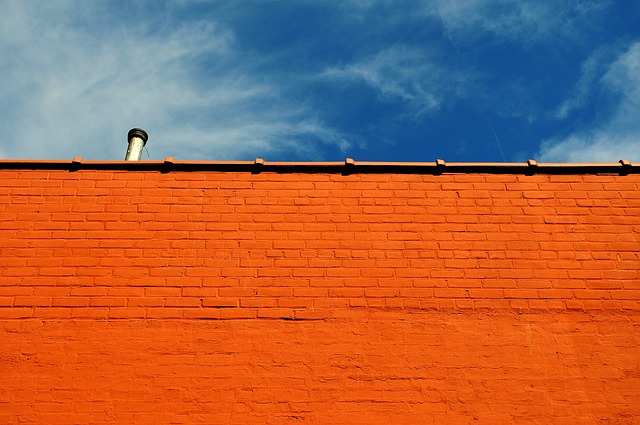
Convex seams are painted with a thin brush with a contrasting color, emphasizing the pattern of the masonry. With recessed joints, you can create the effect of a light coating with a hard roller, when the protruding areas of the material are painted over. In this case, the paint for the layers is taken of the same color, but different shades... The stone takes on the appearance of an old, weathered one.
You can create bovarian masonry with a brush. After completing the main work, paint over individual bricks with black paint, lightly running the pile over the surface. You can create a specific drawing according to the scheme or do it randomly. Also treat half the number of stones with a light gray or sand tone.
Stores have special materials for painting facades. Can be used for outdoor use and elastomeric paint. It lays down in a thick layer and perfectly protects brick and concrete of joints, penetrates deep into cracks, closing them. Its disadvantage is difficult application and high cost.
Decorative painting of interior walls
In the interior, areas with brutal masonry are increasingly being created. To do this, it is enough to prepare the wall, cleaning it of all strangers, wash it and dry it well. After that, a transparent matte material is applied - varnishes and oil. The number of layers can be made 2 - 3, but the coating should be renewed as necessary.
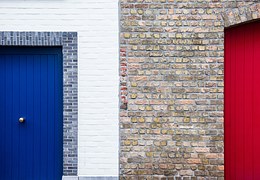
In saunas, bathrooms, laundry rooms, kitchens and other wet areas, immediately cover the wall in 4 layers. After each application of varnish, an exposure should be made, the previous one should be allowed to dry completely. It is better to use a brush and paint over all irregularities very carefully, applying the coating with perpendicular strokes, first vertically, then horizontally.
Monochrome painting
For kitchens and bathrooms, the wall covering must be particularly thick and durable. Moisture should not penetrate the porous brick. Often for this, the wall is covered with a thin layer of putty, then primed and painted. The textured glossy surface adds airiness to the interior and looks style in rooms with themed design.
Decorating masonry in the interior
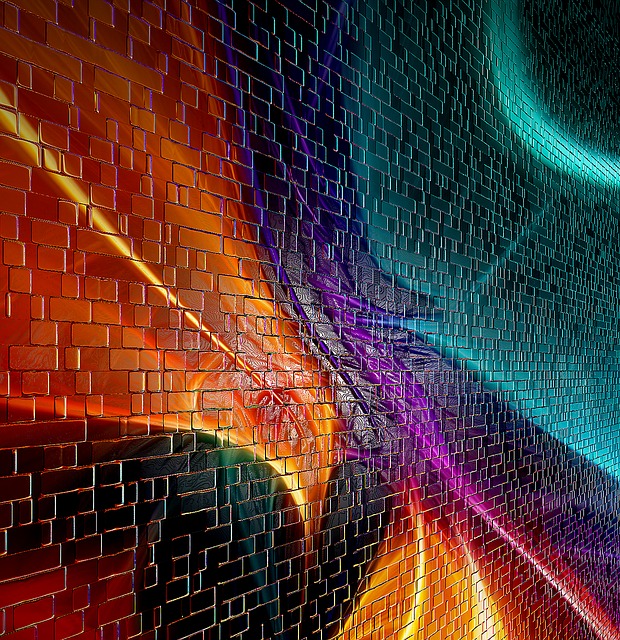
An easy way to make the living room look mysterious is to paint the wall to look like Bovarian masonry. The order is the same as when it was carried out facade work... Only the background can be done with a brush, diligently rubbing the paint in different directions. After drying, create shades.
You can age the stone with a sponge or gauze swab. On the dried background paint, apply a light coating with a different color, creating friability, transparency. This method can also be used when working with a stencil, applying silver and gold highlights on a glossy surface.
There are many methods of creating a decorative colored brick wall using paint. Choose the one that suits you and create a unique image of your home.
Good brickwork itself can play the role of a textured finish, it is not for nothing that a huge number of all kinds of panels and facade systems imitate brick. Also, the New York style of interior decoration has come into vogue, when brick walls are not plastered.
We will tell you what you can paint brick wall inside and outside the premises and how to do it yourself.
Brick painting
Properties and purpose
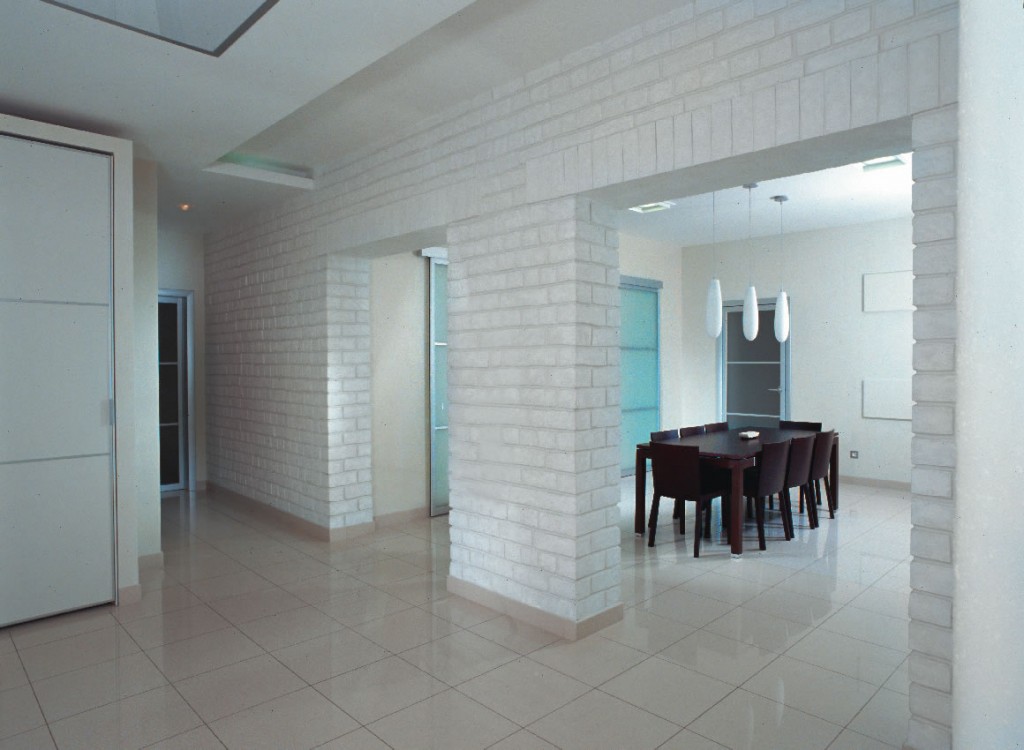
For these purposes, the wall surface should be covered with a protective layer of paint or varnish, which should have the following properties:
- Water resistance... It is especially important for often requiring this quality, because the cladding of bathrooms, toilets and kitchens must also withstand high humidity. Plus, the moisture resistant paint is easy to clean and your walls will always look like new;
- Vapor permeability... The beauty of brick walls lies in their ability to "breathe", that is, let water vapor pass from the inside out. To prevent such emission from being disturbed, the paint must be vapor-permeable;
- Resistant to UV and other types of solar radiation... Under the influence of light in the UV spectrum, many materials fade over time, which is unacceptable for facade and interior paints;
- If the surface will be outdoors, then its coating must be frost-resistant.;
- Elasticity... The film covering the brick must be sufficiently elastic so as not to crack or flake off when the geometry changes during shrinkage processes and thermal expansion of the material;
- Good hiding power on porous and non-uniform surfaces... Not all paints are suitable for working with materials and surfaces such as brickwork, and the consumption may be too high.
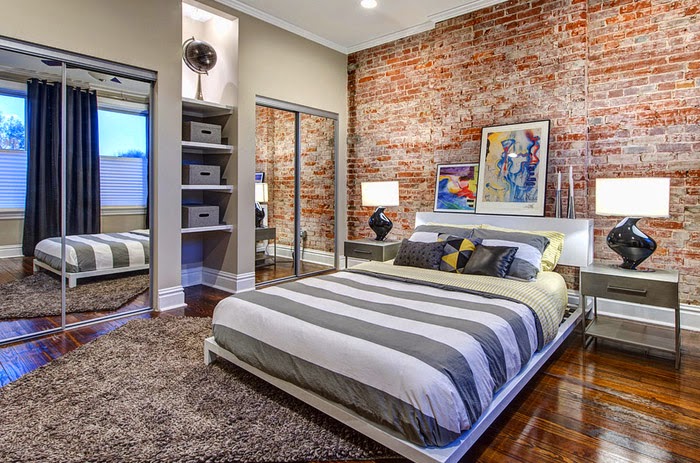
Important!
We see that brick paint should perform two main functions: protecting the material from precipitation, frost and solar radiation, as well as decorating and preserving the external attractiveness of the surface.
Materials (edit)

Modern market building materials provides a huge selection of coatings, paints, varnishes and primers for the treatment of various surfaces, including brick.
In order not to be mistaken when choosing the right material, follow these principles:
- Look for materials made with water or compounds that are harmless to humans. Previously prepared based on organic solvents, since only with such a composition could the desired coating qualities be achieved. Today the situation has changed, and excellent and reliable paints and varnishes are made on the basis of water;
- Be sure to pay attention to the purpose of the coating specified in the manufacturer's instructions. Pay particular attention to the place of use: outdoor or indoor work, dry or damp rooms, heated or unheated, etc .;
- Choose materials with good vapor permeability. A brick wall absorbs moisture from the interior and takes it out, so the paint must let water vapor pass;
- Check if the option you have chosen is suitable for processing porous and non-uniform surfaces;
- Choose well-known manufacturers with a good reputation and a solid history of producing quality materials. It is best to buy products from European manufacturers such as Tikkurila, Belinka, Caparol, Dulux and other firms of this level.

Any cement, silicate or polymer paint is suitable for painting a brick surface, varnishes and glazing can also be used, however experts advise opting for acrylic water dispersion paint... This material is absolutely harmless, strong, beautiful and durable.
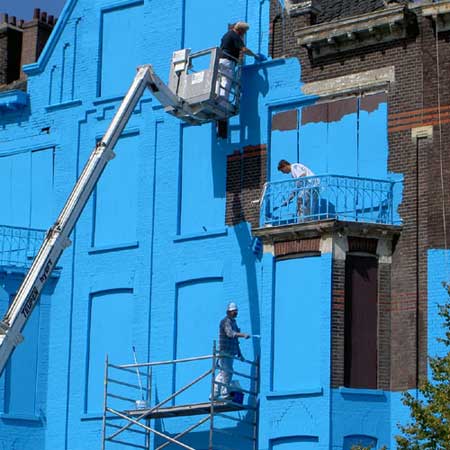
Important!
For interior decoration, you can use facade paint, but interior paint will not work for the facade.
For interior work, you can use varnish on water based... Modern scuba diving equipment looks great and has excellent characteristics, they are completely harmless and have a long service life.

After choosing a paint, select a primer immediately. For acrylic dispersion, medium to deep penetration acrylic primer should be used. Also, it will not be superfluous to immediately purchase an antifungal composition and a means for removing efflorescence from the wall.
Stages of work
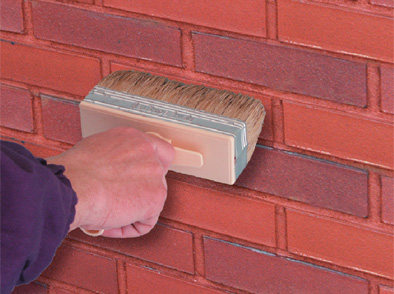
So, we have determined how to paint a brick wall, now let's talk about how it should be done.
For convenience, we have compiled an instruction:
- We clean the surface of the wall from dust and dirt, eliminate efflorescence, wash off the fungus and moss, repair large cracks and slightly embroider the seams;

- When the wall is dry after washing, apply a primer on it with a roller or brush, thoroughly covering the entire area of the wall with it. Leaks and drips must be removed with a sponge or cloth. Because of the primer, the price of finishing increases, but this is a justified waste; (See also the article.)
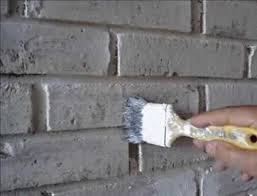
- After the soil has completely dried, open the paint, shake it thoroughly and pour it into the tray. We dip a brush and apply the material to the wall with neat strokes, first we apply the first layer, which we carefully rub into the surface, and after it dries, the second. After the second layer has dried, a third can be applied for extra reliability and strength of the coating.
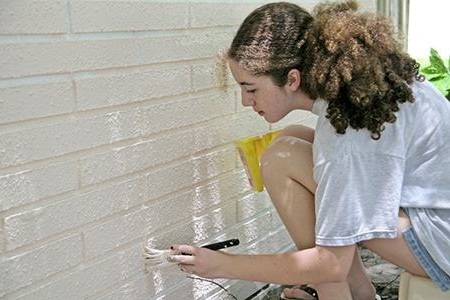
Important!
We make the layers thin, applying thick layers is wrong, they can cause sagging and uneven thickness of the coating.
Output
Painting a brick wall protects the surface of the masonry from the effects of the atmosphere and sunlight, and also preserves its decorative properties. You can complete all stages of work on your own, and our instructions and video in this article can help with this.
- Required materials and tools
- Choosing the right paint
- In what order should work be done
- How to repair cracks
- Correct primer
- How to paint a brick wall
When the brickwork of the house is even and neat, you can not plaster it, but simply paint it. This is done so that moisture does not get under the brick and mortar. Over time, the wall can collapse from excess moisture. And of course, this will not only protect the masonry, but also decorate your interior. Below we will take a look at how to paint a brick wall yourself.
Painting a brick wall is necessary so that moisture does not get under the brick.
Brick walls can be painted not only from the outside, but also from the inside. A good design solution can be to paint those places on the walls where brickwork is visible. Especially inside the living space. For this, it is best to use a special, breathable paint. To paint a brick wall in a bathroom or dining room, a waterproof paint is suitable. Acrylic paint- ideal for a hallway.
Required materials and tools
What do you need for painting? It all depends, first of all, on the wall, on its condition, as well as on whether it is a facade or an internal one. But let's start in order. You need to prepare the following tools:

Before painting, the wall must be cleaned of the old coating and sanded.
- wire brush or washcloth;
- roller or brush, preferably with stiff bristles;
- sponge;
- spray;
- scraper knife;
- sandpaper;
- protective glasses;
- rubber gloves.
You will need the following materials:
- detergent for walls;
- dye;
- cement;
- grout;
- primer.
To avoid tool wear on the rough brick surface, purchase high quality and durable tools such as rollers, brushes and brushes.
Back to the table of contents
Choosing the right paint
Regardless of which brick wall you are going to paint, external or internal, in any case, it is best to use facade paint. Such types of paint are especially interesting:

Latex paint for bricks is elastic and adheres well to cracks.
- Acrylate.
- Latex.
- Acrylic.
This coloring agent is specially designed for porous and non-uniform surfaces.
Brick paint has its own differences from any other types of coloring agents. First of all, it is more elastic and penetrates better under the masonry. Such interesting properties allow it to glue cracks and small gaps between masonry.
When buying paint in a hardware store, ask a consultant for which walls it is intended. There is one that is great for painting worn walls and one that is ideal for covering new masonry. That is, the differences lie in its composition, in the operational period, and, of course, in quality. For small areas, you can use enamel or acrylic. These types are perfect for interior paint jobs.
Back to the table of contents
In what order should the work be done
Basically, all painting work is carried out in 3 stages, this;
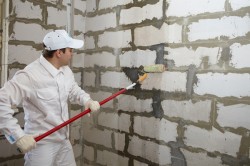
Before painting, the wall must be properly primed.
- The preparatory stage is the preparation of the wall to be painted.
- Padding.
- Coloring.
You need to start with preparation. This will determine how long the paint will last. Proper preparation should include the removal of all wall defects - small cracks, irregularities, bulges. If the wall is not completely flat, then a high-quality painting will not work. Remember this when preparing the surface for painting. Using a scraper and sandpaper, remove all visible defects and proceed to seal the cracks.
Back to the table of contents
How to repair cracks
To start with detergent and a stiff wire brush, clean the entire surface to be prepared. Remove all residues of whitewash and traces of old paint if the wall has already been painted before. You can also use a solvent for these purposes, it all depends on how uneven the surface is.

When painting the wall, you need to protect your eyes with special glasses, put gloves on your hands.
If there is mold or lime stains on the wall, then the masonry will not last long. In such places, moisture absorbed from the outside accumulates. Accordingly, it is necessary to eliminate the presence of mold and plaque. For this, special solutions are usually used. Brush all areas where mold and stains are visible. Finally, rinse off the solution with water. When working with the solution, observe safety precautions - wear safety glasses and gloves.
Now once again carefully inspect the entire surface of the treated wall. There should be no defects on it. If there are small cracks left, it's okay, they will be repaired with paint. If there are strong cracks, they need to be cemented. Clean them of dust and dirt, then seal them up with cement mortar.
The next step is to level the wall with a washcloth or brush. When the entire preparation process is over, the wall should be dried. The complete drying period can take from 10 days to 3 weeks. The main thing is that the surface becomes completely dry, otherwise, after applying a layer of new paint, fungi and mold will form after a while. When the wall dries up, you can proceed to the next stage - priming.




